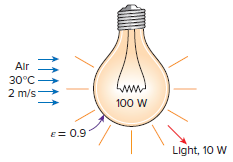An incandescent lightbulb is an inexpensive but highly inefficient device that converts electrical energy into light. It
Question:
Consider a 10-cm-diameter 100-W lightbulb cooled by a fan that blows air at 30°C to the bulb at a velocity of 2 m/s. The surrounding surfaces are also at 30°C, and the emissivity of the glass is 0.9. Assuming 10 percent of the energy passes through the glass bulb as light with negligible absorption and the rest of the energy is absorbed and dissipated by the bulb itself, determine the equilibrium temperature of the glass bulb. Assume a surface temperature of 100°C for evaluation of μs. Is this a good assumption?

Fantastic news! We've Found the answer you've been seeking!
Step by Step Answer:
Related Book For 

Fundamentals of Thermal-Fluid Sciences
ISBN: 978-0078027680
5th edition
Authors: Yunus A. Cengel, Robert H. Turner, John M. Cimbala
Question Posted:





